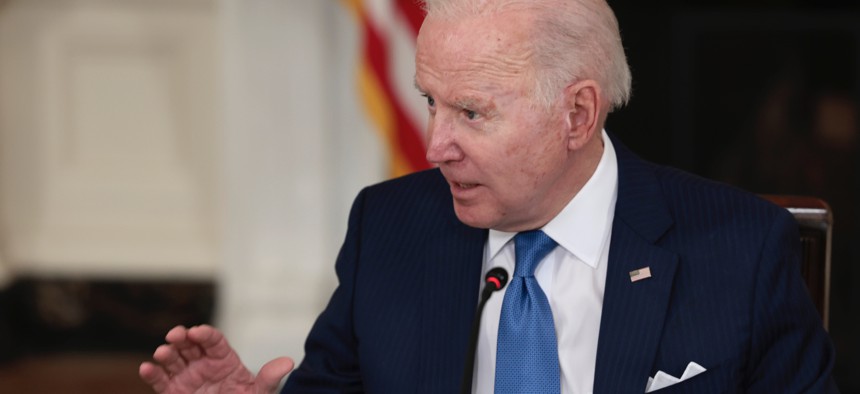Biden administration preps potential largest ever federal carbon-free electricity purchase
New efforts are part of an aggressive timeline for agencies to reduce their emissions.
The Biden administration is preparing what could become the federal government’s largest-ever purchase of carbon-free electricity as it looks to deliver on the president’s ambitious goals to reduce the carbon footprint of federal agencies.
The General Services Administration and Defense Department are looking for contractors who can offer the electricity for agency facilities throughout the mid-Atlantic and Midwest, including all or parts of Delaware, Illinois, Indiana, Kentucky, Maryland, Michigan, New Jersey, North Carolina, Ohio, Pennsylvania, Tennessee, Virginia, West Virginia and Washington, D.C. All of those areas are served by the PJM Interconnection transmission operator.
In its request for information, GSA and Defense asked potential bidders what their capacity is and how that could change over time, how their carbon-free energy prices compare to standard electricity, what the management costs might be and if they could support a 10-year contract. The administration is looking to provide through the forthcoming contract about 2.7 million megawatt hours annually through either direct electricity or the purchase of energy certificates.
That would mark “one of the federal government’s largest-ever clean electricity purchases,” GSA said, and potentially set a new record.
“This procurement will mark a key milestone as we continue to incentivize more production and delivery of clean energy,” said GSA Administrator Robin Carnahan. “We’re using the government’s buying power to spur demand for clean, carbon pollution-free electricity, and we’re partnering with industry to drive toward the triple win of good jobs, lower costs for taxpayers and a healthier planet for future generations.”
President Biden in 2021 released his Federal Sustainability Plan to make federal agency operations entirely carbon-neutral by 2050. As part of an executive order to meet that goal, Biden mandated that all agencies maintain net-zero emission buildings by 2045.
By 2032, agencies will have to cut emissions in all federal buildings, campuses and installations by 50% compared to a 2008 baseline. Already, all new, large construction and modernization projects have to include building designs that are net-zero emissions and reduce waste and water usage. Agencies have until 2030 to ensure at least 30% of their current facilities are retrofitted to eliminate emissions and they use 100% carbon-free electricity.
Administration officials said the government is forging new economies of scale to bring down the price of non-polluting electricity. New agreements it has made in recent years are expected to bump the government’s reliance on clean energy from 38% to 47%.
A recent inspector general report found that in 2021, between just 11% and 19% of electricity at buildings in GSA’s portfolio came from renewable sources. In the same report, agency officials said some of Biden’s goals were not realistic, as they were too costly and would require technology not yet available.
A GSA spokesperson said in September newly available funds from measures such as the Inflation Reduction Act and the Infrastructure Investment and Jobs Act would accelerate progress.
The money “will empower GSA to increase energy efficiency, electrify federal buildings, expand our use of carbon pollution-free electricity and buy more low-embodied carbon materials, helping to catalyze industry efforts to accelerate decarbonization in U.S. markets, create good clean energy jobs and ultimately achieve the Administration’s goals for sustainable, net-zero federal buildings,” the spokesperson said.
GSA and Defense estimated it could issue a solicitation for the electricity plan in May, with an award in September. The agencies will host an “industry day” on Feb. 20 to further discuss its expectations with potential bidders.
“President Biden directed the federal government to use its scale and procurement power, as the nation’s largest energy consumer, to support the growth of America’s clean energy industry and clean energy jobs, and do so in ways that are good for our taxpayers and our communities,” said Andrew Mayock, the federal chief sustainability officer within the White House’s Council on Environmental Quality. “Through our federal demand for locally-made clean electricity, we will spur new clean electricity production, which is good for our climate, our economy and our national security.”








